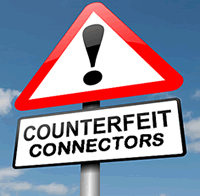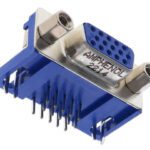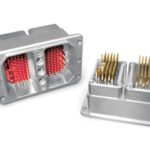Breaking the Counterfeit Connection
 Breaking the Counterfeit Connection
Breaking the Counterfeit Connection
Electronic component counterfeiters have two fundamental priorities: making easy money and not getting caught. Peddling bogus semiconductors holds the promise of a substantial payday but even counterfeits can be costly to produce, and the risk of detection has grown significantly in recent years as awareness of the problem and the responding counterfeit detection technologies have increased. Even so, offshoring has exposed intellectual property to a capable manufacturing arena, and for some counterfeiters, the rewards are worth the risks. This is why I believe that the electronics supply chain should prepare itself for a potential surge in the number of counterfeit interconnect, passive, and electromechanical (IP&E) products making their way into the channel.
Though the US Department of Defense’s Standardization Program Office reported in 2012 that only 7% of counterfeit electronic components are “non-semiconductor” types, I suspect that this number does not reflect the true extent to which IP&E has already infiltrated the electronics supply chain. I admit there are no studies to back up my gut instinct on this matter. But consider this: How often do you see a store clerk check a $1 bill for authenticity? I can’t say I have — but when someone hands over a crisp new $50 or $100 bill, the counterfeit pens and UV lights come out. How many fake $1 bills do you think are taken in on a daily basis? We don’t know, because people don’t check.
Similarly, in the electronics sector, the majority of the counterfeit detection/prevention measures currently in place focus on high-cost integrated circuits and semiconductors. But it is time for the industry to recognize that whether the fake parts are $500 microprocessors or $5 connectors, they pose significant performance, reliability, safety, and economic risks to everyone involved in the manufacture, distribution, and operation of the end product in which they are utilized.
Plugging the Leaks
If we are truly committed to winning the battle against counterfeit components, we must first plug the leaks in the supply chain. The best way to do that is to source only from original component manufacturers or their authorized distributors and resellers. According to a 2012 report by the Senate Armed Services Committee, an “overwhelming majority” of the more than one million counterfeit parts identified in an investigation of the Department of Defense’s supply chain were sourced from the open market. In addition, an audit of the US Missile Defense Agency’s independent distribution sources determined that 60% of the suppliers were a “moderate to high risk for providing counterfeit parts.”
That is not to say that every open market source deals in counterfeit product. Many independent distributors have legitimate businesses serving the components’ aftermarket. However, there are also those that intentionally engage in the manufacture and sale of counterfeit, re-marked, and substandard parts, and unfortunately, these bad apples can spoil the whole bunch.
Buyers must keep in mind that gray-market products typically change hands and regions many times before they land in a broker’s stock. With each transaction and every shipment, the opportunity for the parts to be tampered with, repackaged, or relabeled is high. Without a verifiable paper trail, the ultimate seller generally cannot guarantee the authenticity or quality of the product. In contrast, an authorized distributor can provide buyers with certificates of compliance and origin.
Seek and Ye Shall Find
Regardless of the source of your inventory, it is always a good idea to keep an eye out for telltale signs of fraud. When you receive a shipment, the first thing you should do is inspect the box and internal packaging for signs of tampering. For example, due to the growing prevalence of counterfeit cable in the North American market, Underwriters Laboratories now requires holographic labels on boxes of cable that bear the UL logo. If you receive a shipment without this distinct marking, you should be wary.
It’s also advisable to review the printed documentation that accompanies the parts. Look for blatant grammatical errors, sloppy layout, and inconsistencies in the corporate logo. Suffice to say, if the manufacturer’s name is misspelled, the odds are you have fake parts on your hands.
Though “good” counterfeits can only be detected through sophisticated testing, product quality is not typically a major concern for many counterfeiters. Parts may show signs of remarking and physical alteration, including sanding or blacktopping — a method of removing original product markings.
No More Surprises
With the weight of keeping millions of dollars worth of production lines moving sitting squarely on their shoulders, desperate buyers are easy targets for counterfeiters. These days, however, given the acceleration of component lifecycles and the increased use of commercial parts in sectors such as mil/aero, it should come as no surprise to these OEMs that their end products will outlive many of their electronic components. Yet, according to IHS iSuppli, 57% of reported incidents of counterfeit parts involved obsolete or end-of-life (EOL) parts.
For OEMs with long-field-life products, the best approach is to plan for obsolescence. OEMs should work closely with their distributor partners to proactively manage their bill of materials. Avnet, for example, offers tools, such as our BOM Optimizer, that enable us to identify parts with potential obsolescence issues, prioritize those that could cause the greatest disruption, and develop cost-effective solutions. There is also a team of market analysts whose sole purpose is to follow market and technology trends and communicate regularly with component manufacturers about component transitions.
When a supplier issues an end-of-life notice, a distributor should offer customers a range of options, including lifetime buys, to assure ongoing supply. It should also be able to recommend certified, reliable, and reputable aftermarket manufacturers who are authorized by the original component manufacturers to produce legacy components using original wafers and die. As well, Components Direct, an Avnet company, is an authorized source for end-of-life product. Its stock is traceable, reliable, and guaranteed direct.
Despite all these measures, there is only one thing that will truly stop counterfeit components from infiltrating the electronics supply chain — and it comes down to buyer behavior. Too many buyers engage in risky sourcing behaviors. Until that changes, nothing else will. So, my advice to buyers is to remember that they don’t just need parts: They need quality, reliable, factory-original parts. There is a critical difference.
 Ed Smith, a 20-year veteran of the electronics industry, was appointed president of Avnet Electronics Marketing Americas in February 2009. Contact him here.
Ed Smith, a 20-year veteran of the electronics industry, was appointed president of Avnet Electronics Marketing Americas in February 2009. Contact him here.







